Current season
Your Lawn & Garden
Early Spring, 2001
The period from Valentine's Day to mid-March is really the most intense segment of the gardening year in the Deep South, so let's get busy...
Top Tips
This is the last chance to get all those clean up, paint up, fix up chores done before perennials break their dormancy and spring planting season begins. Rake the leaves from the lawn and flower beds. Use them to mulch around trees and shrubs; compost the rest. Get your soil tested if you've been putting it off. Sharpen and oil tools like shovels, hoes, clippers, etc. Change the oil and filters and belts on power equipment.
Review your gardening journal from last year. If you've never kept one, now's the best
time to start. Make note of what plants you buy, when and where you plant them, how
often you feed and prune them, what's blooming when, plant problems and successes —
it doesn't have to be elaborate or burdensome, just enough to answer your own questions
at a later date.
Trees & shrubs
MORE THAN ANY OTHER SEASON, early spring is when trees and shrubs steal the show. From azaleas to camellias to redbuds, dogwoods, saucer magnolias and flowering cherry trees, the urban landscape is an ocean of color.
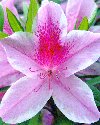
![]() IT'S TIME ONCE AGAIN for the dazzling display of
Azaleas at the Thomas Center Gardens
in downtown Gainesville (Florida). In fact, the whole city looks
like an azalea festival right now. There's even a new azalea/camellia
garden at Kanapaha Botanical Gardens,
featuring dozens of shapes, sizes, colors and varieties, including native azaleas,
alongside the historic William Bartram Trail.
IT'S TIME ONCE AGAIN for the dazzling display of
Azaleas at the Thomas Center Gardens
in downtown Gainesville (Florida). In fact, the whole city looks
like an azalea festival right now. There's even a new azalea/camellia
garden at Kanapaha Botanical Gardens,
featuring dozens of shapes, sizes, colors and varieties, including native azaleas,
alongside the historic William Bartram Trail.
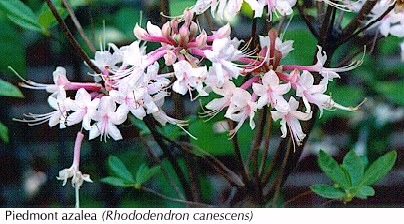
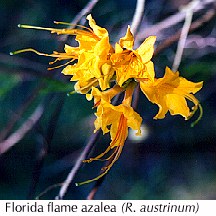
So now is the best time of the year to shop for azaleas and camellias. Why? Because you can see them in bloom — no guessing about what color and type of flowers they'll have. Azaleas and camellias prefer similar growing conditions: shade (they can tolerate some direct morning sun, but not afternoon sun) and rich, well-drained, acidic soil (they don't like soggy soil or over-watering). Although they're susceptible to a few pests and diseases, once established they're generally healthy, long-lived, low-maintenance plants.
If you have camellias, fertilize them when they're done flowering. There are fertilizers specially formulated for camellias and azaleas — they'll give the best results. If you have azaleas, this is a good time to put mulch around them, to keep down weed growth and slow down the evaporation of water from the soil.
NOW IS THE PRIME TIME OF THE YEAR FOR PRUNING many trees and shrubs. DON'T prune azaleas or camellias now, though. In fact, there's almost no need to prune azaleas and camellias at all, except to removed damaged limbs.
For azaleas, camellias and these other winter- and spring-flowering trees and shrubs, wait and prune them during the first two months after flowering is over:
African tuliptree redbud dogwood saucer magnolia fringe tree spirea gardenia star magnolia hydrangea wisteria Indian hawthorn
Prune these summer- and fall-flowering trees and shrubs
abelia mimosa cassia oleander crape myrtle princess flower/tibouchina goldenrain tree roses hibiscusabout the time they come out of their winter dormancy (any day now). You can tell they're coming out of dormancy when the first signs of new growth — little green things — appear on the stems.
Evergreens such as
boxwood juniper podocarpus holly ligustrum wax myrtlecan be pruned any time (except that you probably don't want to cut off flower buds).
If you're new to pruning, take a look at some of the excellent Extension publications on pruning available online. And if you've never heard the phrase "crape murder," see Southern Living's famous article before you try pruning crape myrtles.
WHAT TO PLANT: If you have any bare - root or balled - and - burlapped trees or shrubs get them in the ground immediately, if not sooner — late fall and winter is really the proper time to plant them. Containerized trees and shrubs can be planted any time (other than during freezing cold), except that palms and cycads are best planted from late spring to mid-summer. If you have bare-root roses to plant, soak the roots in water for eight hours or overnight just before planting them.
WHAT NOT TO PLANT: Habitat destruction from invasive non-native plant species rivals the destruction to native ecosystems from building and construction. We mention several invasive exotic problem plants — ligustrum, mimosa, podocarpus (P. macrophylla) — in the lists above because they're already present in so many people's yards. We'd like to see as many of these as possible, along with nandina and coral ardisia, replaced with well-adapted, well-behaved native plants.
Flowers & foliage
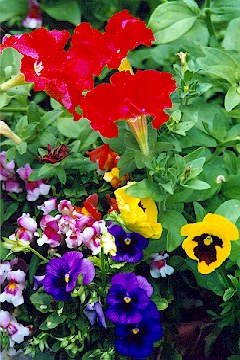
![]() PANSIES, PETUNIAS AND SNAPDRAGONS — for the winter
months they were the primary sources of living color.
You can still plant them and the other cool-season annuals now
and they'll continue to flower through most of May, until
they can't take the heat any longer.
PANSIES, PETUNIAS AND SNAPDRAGONS — for the winter
months they were the primary sources of living color.
You can still plant them and the other cool-season annuals now
and they'll continue to flower through most of May, until
they can't take the heat any longer.
Tulips, crocuses and hyacinths traditionally herald the spring up north, but not here. However, some types of daffodils (Narcissus) perform well here, the most common being paperwhites. Buy daffodils from a local nursery that you can trust to sell you varieties that are well adapted for our climate.
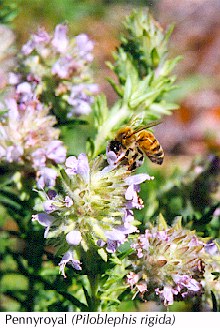
![]() Certain native wildflowers bloom in late winter and early spring, before the garden
centers overflow with domesticated bloomers.
Pennyroyal and spiderworts reward the
honeybees that venture out on the first warm, sunny days. Pennyroyal is in
the mint family, which you can easily verify by sniffing its needle-like leaves.
In the wild it grows in piney scrub land, so give it sun or light shade, and well-drained,
slightly acidic soil. It's evergreen and fairly drought tolerant.
Certain native wildflowers bloom in late winter and early spring, before the garden
centers overflow with domesticated bloomers.
Pennyroyal and spiderworts reward the
honeybees that venture out on the first warm, sunny days. Pennyroyal is in
the mint family, which you can easily verify by sniffing its needle-like leaves.
In the wild it grows in piney scrub land, so give it sun or light shade, and well-drained,
slightly acidic soil. It's evergreen and fairly drought tolerant.
If you go shopping at native plant nurseries or herb gardens for the pennyroyal shown here, be sure to ask for it by its botanical name, Piloblephis rigida, because there's another plant called pennyroyal, completely different in flower and foliage, and just to be confusing, it's also in the mint family.
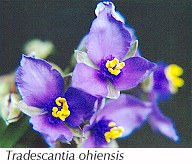
![]() Spiderworts (Tradescantia ohiensis) are sometimes available from nurseries, but they're so abundant in yards
and ditches that most people consider them weeds and pull them up. We
like to use our handy bulb planter tool to pick up strays and move them into
confined areas and borders.
Spiderworts (Tradescantia ohiensis) are sometimes available from nurseries, but they're so abundant in yards
and ditches that most people consider them weeds and pull them up. We
like to use our handy bulb planter tool to pick up strays and move them into
confined areas and borders.
As a mass planting, they make a graceful, billowy groundcover. From early spring to early summer they provide a cloud of blue mist from dawn until midday, when the flowers close up. By midsummer they will have disappeared, but in winter they're among the first greenery to come up. They're happy in wet or dry, rich or sandy soil, in sun or shade. When the weather finally heats up and the flower heads appear spent, snap them off to induce another round of blooming. When the whole plant turns brown, break it off at ground level — avoid pulling it up by the roots — and toss it in the compost.
A couple of early-flowering native vines deserve mention: crossvine (Bignonia capreolata) and Carolina or yellow jessamine (Gelsemium sempervirens). Both are cold-hardy evergreens with showy, fragrant flowers that attract butterflies and hummingbirds. Both can be used as groundcovers or fence covers. They grow in sun or shade, and prefer rich soil but will take what they can get. Crossvine is a fast grower; jessamine takes its time.
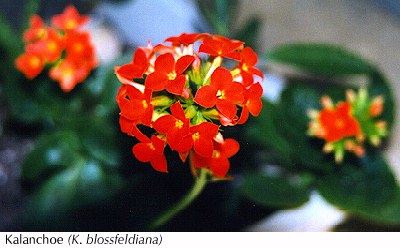
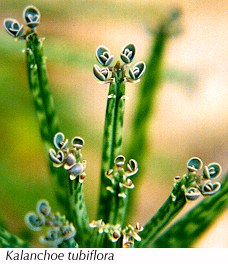
![]() Mother of thousands (K. tubiflora)
gets its name from its ability to produce a mind-boggling number of
baby plants in a short time. It does this by a fascinating technique:
growing "plantlets" along the edges of its leaves. The plantlets are
able to fall off and take root almost anywhere (even in carpets!). It
seems no soil is too poor nor too dry for this species. They don't seem
to mind freezes very much, either.
Mother of thousands (K. tubiflora)
gets its name from its ability to produce a mind-boggling number of
baby plants in a short time. It does this by a fascinating technique:
growing "plantlets" along the edges of its leaves. The plantlets are
able to fall off and take root almost anywhere (even in carpets!). It
seems no soil is too poor nor too dry for this species. They don't seem
to mind freezes very much, either.
They're seldom seen for sale in stores, but that's not a problem. If you see an adult plant, there'll probably
be hundreds of babies underneath it. Pull up a couple of the tiny plants, roots and all. Plant them, don't overwater
or step on them, and in a year you'll have more of them than you know what to do with.
Plant them in the same type of site where you'd plant cactus; in fact, they make interesting looking companion plants.
WARNING: In case we haven't made it clear enough, this plant can become an invasive pest. If you want to grow it and minimize the risk, plant it in a container that you can keep in a paved area or indoors.
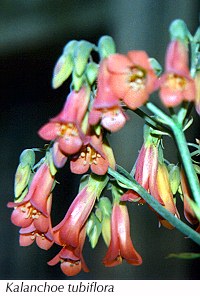
![]() Like its cousin, the common kalanchoe, in early spring it produces clusters of flowers —
waxy, coral-colored trumpets that dangle upside down like tubular bells. They make
interesting and unusual cut flowers that last a relatively long time.
Like its cousin, the common kalanchoe, in early spring it produces clusters of flowers —
waxy, coral-colored trumpets that dangle upside down like tubular bells. They make
interesting and unusual cut flowers that last a relatively long time.
Both types of kalanchoes are easily propagated from cuttings. Break off a leaf or a stem.
Give it a couple of days in the open air for the wound to dry and form a scab, then plant
it, water occasionally, and soon it will root. Doesn't get much easier than that.
THIS IS THE BEST TIME OF YEAR for a number of chores in the flower garden. Remove fallen leaves and accumulated debris from flower beds to give light to new seedlings and reawakening perennials. Install soaker hoses in flower beds before the growing plants get in the way. Plant your holiday poinsettias in rich, well-drained soil along a south-facing wall; feed them when new leaves appear. Divide and conquer cannas, crinums and other summer-flowering bulbs and perennials that have gotten overcrowded. Fertilize bedding plants lightly and frequently as new growth begins to take off.
WHAT TO PLANT: There's still time to transplant a number of cool-season annuals, but mainly we're entering the beginning of planting season for warm-season annuals and perennials. There's still lots of time to start seeds for warm-season plants. In our climate, the cool-season plants will be dead or dying by the end of May, and many of the warm-season annuals planted now will be worn out by mid-July, so plan on repeat plantings over the next few months so you can extend the colors of summer.
Even though there's still some risk of frost and freezes, transplants of the following can safely be planted now:
alyssum Marguerite daisy baby's breath (Gypsophila) nasturtium calendula pansy candytuft (Iberis) petunia China doll carnation snapdragon delphinium statice dianthus Stokes aster dusty miller sunflower foxglove (Digitalis) sweetpea lobelia yarrow (Achillea)
These bulbs (and bulb-like plants) can also be planted now:
achimenes kaffir lily (Clivia) African lily (Agapanthus) marcia caladium morea canna spider lily crinum tritonia (Crocosmia) dahlia tuberose Dutch iris voodoo lily gloriosa watsonia ixia zephyr lily
The fun will only continue and get better! In a couple of weeks, the danger of frost will be almost (almost!) nil, nighttime temperatures will be considerably warmer, the list of what we can plant will double overnight, and there'll be new surprises in the garden every day.
In the meantime, tell your friends about Southern Gardening, and don't grow anywhere without us.

Fruits & vegetables
EARLY SPRING IS EITHER the beginning or the beginning of the end of the vegetable gardening season.
If you've had (and still have) cool-season veggies, it's the beginning of the end —
too late to start new cool-season plants from seeds, and just barely enough time to transplant seedlings and get a
harvest before the hot weather does them in.
If you can find them, you can still plant
beets green onions broccoli kale cabbage kohlrabi carrots leeks cauliflower lettuce (leafy types) celery mustard Chinese cabbage parsley collards potatoes endive-escarole radishes English peas turnipsRemember to protect them if the weather forecast calls for a hard freeze.
Herbs, mostly cool-season herbs, that can be planted now include
chervil parsley chives rosemary coriander sage dill sweet marjoram garlic thyme
If you've let your veggie garden rest during the fall and winter, this is the beginning for a warm-season vegetable crop. If you've been putting off getting the soil tested, go ahead and get that over with. Prepare the soil for the spring garden. Work in lots of organic matter, such as composted cow manure and compost from your compost bin, and wait a couple of weeks before planting. Remove weeds and insect pests from plants in the garden area, preferably by hand or other organic means.
It's a good time (the best time would have been about a month ago) to start your own transplants for the warm-season crops that aren't sown directly in the garden — cucumbers, eggplant, pepper and tomatoes, for example.
Fruit trees can be planted according to the same guidelines as for trees and shrubs in general.

Conventional lawns. Mow and water as needed; this being the dry season, it's likely watering will be more needed than mowing. Hold off on fertilizing your lawn grass until the weather warms up. Rake leaves and debris and use them for mulch around trees and shrubs or add them to your compost bin.
Remove thatch — grass growing on top of other grass, rather than in the soil. Some mowers have a "de-thatch" setting, or you can use an ordinary rake. It'll be easier to get it now than any other time. And if you don't, it'll just get worse.
It's the best time to apply a pre-emergent herbicide to stop (weed) seeds from germinating in your lawn. Be careful not to apply it in flower beds that you want to re-seed naturally. And be sure to read the label carefully even before you buy an herbicide. Many of the popular "weed and feed" mixtures contain chemicals that should not be used near streams, bodies of water, areas that drain directly to the aquifer, or where children or animals will be exposed to the chemicals.
Unconventional wisdom. This is the best time to work on reducing the size of your conspicuously unused urban cow pasture. Quit waging chemical warfare against Mother Nature if she's trying to tell you grass doesn't want to grow in certain parts of your yard. Pull up those scraggly shreds that remain and make a plan for putting in groundcovers or decorative mulch or hardscape (stones, paving) in those areas.
And you're better off in the long run if you can replace sizeable chunks of the lawn with low-maintenance flower beds. Wouldn't you get more enjoyment out of a butterfly and hummingbird garden based on colorful, drought-tolerant native plants? Think about it the next time you're pushing that bull around by the tail in 95° weather.
Until then, in the words of Joni Mitchell: "We are stardust, we are golden, and we've got to get
ourselves back to the garden."

Then don't beat around the bush —
leaf us a message.
Copyright © 2001 by Southern Gardening
Disclaimer: Our advice is based on our own experience and the recommendations found in other reputable sources. Due to the impossibility of anticipating all the conditions under which our advice might be applied, we can assume no liability for the results our readers obtain from following our advice.
We sometimes mention specific product names in this column in order to provide examples of the categories we are describing. We do not necessarily endorse one product over any other in the same category.